September 28th, 2012
 Likeable people have more influence and get more offers. Likeable employees sell more products and delivery more satisfying customer service. Likeable leaders and managers are far more effective. It is little wonder that becoming more likeable and creating lovable products and services is big business for designers.
Likeable people have more influence and get more offers. Likeable employees sell more products and delivery more satisfying customer service. Likeable leaders and managers are far more effective. It is little wonder that becoming more likeable and creating lovable products and services is big business for designers.
Likeablility is a bit illusive so I am always on the lookout for positions and studies that make it concrete enough to be useful for cognitive designers. I’ve found six positions strong enough to offer a design framework and have developed two of my own.
For a good introduction I suggest you start with Likeonomics: The Unexpected Truth Behind Earning Trust, Influencing Behavior and Inspiring Action. The book does a good job of clarifying the link between being liked and economic value creation in business and stressing that being likeable is not about being nice. It also explains how likeability is driven by truth, relevance, unselfishness, simplicity and timing. Each of these general principles is further analyzed. For example, being relevant (get people care) is broken down into having a meaning point of view, active listening and working the surrounding context.
I am interested to hear from readers that have worked on likeability applications. What was the challenge? How did you define and operationalize likeability?
Source of image: The True Storyof the Making of Likeonomics

Posted in Behavior Change, Examples | 1 Comment »
September 23rd, 2012
A recent paper on Self Determination Theory Applied to Health Contexts: A Meta-Analysis, claims that health behaviors will change when people feel autonomous, capable and cared for. More specifically, I am most likely to change when I:
- Believe it is my conscious choice or under the control of my will
- Have or can acquire the skills needed to make the change
- Feel a sense of relatedness or understood and cared for.
These conditions create or correspond to intrinsic motivation for the change.
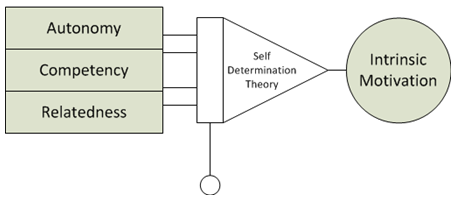
The paper emphasizes that health behavior change lasts when the program designed to bring it about meets the autonomy or volitional needs of participants. That means understanding and respecting a person’s interests, values and choices in the change process. It also means fostering their independence rather than dependence on an externally controlled change process. This maximizes the chance that new routines will be deeply internalized and therefore last.
As cognitive designers know, meeting the volitional or autonomy requirement is hard because many will feel helpless or overwhelmed. Further, many will have made choices or hold values that undermine the new health behaviors. For example, I chose to smoke or be inactive. How can you respect that and help me stop smoking or starting moving more? Resolving these conflicts takes time and considerable experimentation.
The best programs will be patient and offer a caring approach to learning from experience. They will transform initially external motivators into intrinsic motivations.
The key is to provide authentic emotional support and global change control while leaving more specific choices up to the individual. For example, the global goal may be to reduce calories using portion control but it is up to the individual to decide and experiment with ways to achieve that in their daily activities.
Health behaviors stick when I learn the new routines needed to support through volitional actions.

Posted in Behavior Change, Psychographics | 3 Comments »
September 20th, 2012
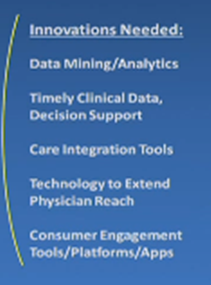 Or so argues Todd Park the chief technology officer (really the chief innovation officer) of Health and Human Services. He makes his case in this video and suggests changing incentives (from volume based to value based) and the democratization of all types of health data are acting as “rocket fuel” for entrepreneurial activity in healthcare. An interesting argument especially since many of the opportunities involve improving health behavior change, care coordination experience, decision making by patients and caregivers and other cognition-heavy challenges. This means:
Or so argues Todd Park the chief technology officer (really the chief innovation officer) of Health and Human Services. He makes his case in this video and suggests changing incentives (from volume based to value based) and the democratization of all types of health data are acting as “rocket fuel” for entrepreneurial activity in healthcare. An interesting argument especially since many of the opportunities involve improving health behavior change, care coordination experience, decision making by patients and caregivers and other cognition-heavy challenges. This means:
Cognitive design and engineering sit right at the heart of many entrepreneurial opportunities in healthcare.

Posted in Behavior Change, Service Innovation | 1 Comment »
September 17th, 2012
 In a recent study of how labels effect school children’s food choices researchers found:
In a recent study of how labels effect school children’s food choices researchers found:
“that by naming plain old carrots “X-ray vision carrots,” fully 66 percent of the carrots were eaten, far greater than the 32 percent eaten when labeled “Food of the Day” — and the 35 percent eaten when unnamed.”
Other behavior changing labels include power punch broccoli, tiny tasty tree tops and silly dilly green beans. These are names the students created.
Vegetables can be transformed into cool new foods with the right labels. New labels invoke a different set of mental models that bias our perception of the food in new ways. The effect appears robust as it works on different age groups and ethnic backgrounds over an extended period of time.
For other evidence-based suggestions on how to nudge health food choices by children check out the Smarter Lunchroom Movement.

Posted in Behavior Change, Service Innovation | No Comments »
September 14th, 2012

Watch the video.

Posted in Related Fields | No Comments »
September 12th, 2012
 The statistics on lying and cheating are alarming. It is little wonder that clients ask – how can I tell if employees and customer are lying or cheating? They are hoping that cognitive design offers additional insights beyond cross-referencing questions, checking sources and the like. So I am always on the lookout for new scientific insights into the psychology of lying, faking and cheating.
The statistics on lying and cheating are alarming. It is little wonder that clients ask – how can I tell if employees and customer are lying or cheating? They are hoping that cognitive design offers additional insights beyond cross-referencing questions, checking sources and the like. So I am always on the lookout for new scientific insights into the psychology of lying, faking and cheating.
Take for example, a recent LiveScience report on research that suggests we tend to lie when under time pressure or when we feel personally justified in doing do. When pressed for time we often look out for our own interests first and lying can serve that. Examples of personal justifications include – it won’t hurt anyone to lie, everyone is lying or I can’t get caught!
These are practical findings. Be sure to give people the time to do the right thing and work to surface and eliminate justifications that support lying.

Posted in Psychographics, Related Fields | No Comments »
September 7th, 2012
Much of the value that is generated in advanced economies comes from knowledge work and emotional labor. Learning, problem solving, innovating, empathizing and emotional control is what we are getting paid for. This puts a premium on understanding how people think-and-feel as they work, use products and experience services. Studying how minds work and using the results to improve knowledge productivity and customer experience is starting to come into vogue.
 One surprise those new to the field often get is how messy real thinking is. When you study how people actually reason in the wild (real world setting outside of a laboratory) you find they can pull on a set of beliefs that are contradictory and strategies that are far from logical and sometimes not even in their best interest. Naturalistic reasoning is very messy.
One surprise those new to the field often get is how messy real thinking is. When you study how people actually reason in the wild (real world setting outside of a laboratory) you find they can pull on a set of beliefs that are contradictory and strategies that are far from logical and sometimes not even in their best interest. Naturalistic reasoning is very messy.
This is especially obvious when people grapple with so-called existential questions about the nature of life, illness and death. A recent psychological study found that when dealing with such questions more than 50% of subjects (ages 5-75 ) mixed scientific (biological) and supernatural explanations to develop answers. For example:
Among the adult participants, only 26 percent believed the illness could be caused by either biology or witchcraft. And 38 percent split biological and scientific explanations into one theory. For example: “Witchcraft, which is mixed with evil spirits, and unprotected sex caused AIDS.” However, 57 percent combined both witchcraft and biological explanations. For example: “A witch can put an HIV-infected person in your path.”
We normally take superstition, science and religion to offer mutually exclusive modes of explanation. Yet they are being mixed together in naturalist reasoning on basic questions. This happens in other context too including the workplace. Cognitive designers must embrace this messiness. That is where the insights are.

Posted in Psychographics | 7 Comments »
September 1st, 2012
Self control is a prized resource. Most of my clients and many students are interested in what it is and how to get more of it. To design programs, products and services that improve self control we must first understand what it feels like. More specifically, what are the unique mental states, frame of mind or thoughts and feelings associated with a state of self control. Until we have insight into that, it will be tough to apply cognitive design to the challenge.
So what does self control think and feel like? We can study the question with introspection, self reports, ethnographic observation and protocol analysis. And hope for an articulation (narrative description) that is accurate and specific enough to provide design insights. We can also study the question with neuroscience and brain scans. While lacking an articulation of the psychological contents, a neuroscientific study can never the less lead to interesting interventions.
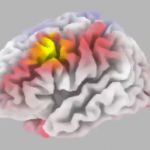 As an example of the neuroscience approach, I recently found a TEDx talk, A Brain Computer Interface for Exercising the Self Control Muscle, by Jordan Silberman a PhD/MD student at the University of Rochester. We might not always know what self control thinks or feels like but we do know what it looks like in the brain (image to the right). Knowing that it is possible to develop an neurofeedback training scheme (see below) that correlates the brain state of self control to an external training signal (a bar that moves up and down on the computer screen.
As an example of the neuroscience approach, I recently found a TEDx talk, A Brain Computer Interface for Exercising the Self Control Muscle, by Jordan Silberman a PhD/MD student at the University of Rochester. We might not always know what self control thinks or feels like but we do know what it looks like in the brain (image to the right). Knowing that it is possible to develop an neurofeedback training scheme (see below) that correlates the brain state of self control to an external training signal (a bar that moves up and down on the computer screen.
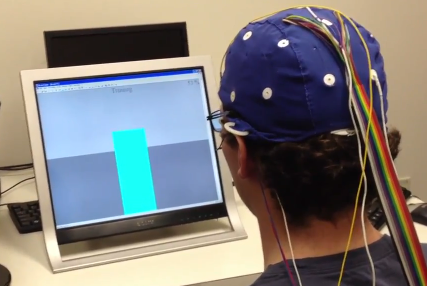
This simple device lets the user learn to put themselves in the mental state of self control through rapid trial and error. By inducing the state you exercise your self control muscle. The video shows one experiment where people that used the training are able to maintain self control far better than the control group.
This is an exciting result with a lot of implications for cognitive designers once the technology matures a bit. In the meantime you have to wonder, do people that go through this training have a better insight into the think-and-feel of self control? Can it be articulated and used to drive design innovations now?
Interested to hear from readers – how do you characterize the frame of mind (intellectual, affective, motivational, volitional) for self control?

Posted in Behavior Change, Brain-Computer Interface, Psychographics | No Comments »
August 29th, 2012
 Cognitive design makes an unique contribution to improvement and innovation efforts by focusing on the workflow between the ears. By discovering and documenting mental processes and psychological needs cognitive designers bring important new requirements, constraints and opportunities to the table. There are five ways to get at the workflow between the ears:
Cognitive design makes an unique contribution to improvement and innovation efforts by focusing on the workflow between the ears. By discovering and documenting mental processes and psychological needs cognitive designers bring important new requirements, constraints and opportunities to the table. There are five ways to get at the workflow between the ears:
- Search the literature and develop a hypothesis. If someone else has already developed a cognitive model of the domain you are working in make use of it. This can include general processes such as recognition-primed decisions making or something more specific such as threat detection in battle field management.
- Do some fieldwork. This means going out and watching and making inferences about what people are thinking and feeling. Ethnographic methods and empathy mapping used in design thinking are popular examples.
- Use lightweight modeling techniques. These often include using validated psychological assessment instruments to measure individual’s strengths, weaknesses and needs against a known model. For example, two instruments that are very useful for cognitive designers are the learning style inventory that gives insights into how individuals learn from experience and the sensory profile that provides a measure of how sensitive an individual is to sensory stimulation. Both these instruments are very useful when you are designing for behavior change.
- Use heavyweight modeling techniques. These are cognitive engineering and artificial intelligence techniques and include for example cognitive task analysis and protocol analysis. With these techniques experts are sometimes asked to think-aloud while they are doing the mental work of interest. These verbal reports are treated as data and are analyzed and scored to develop a model of the mental process. Another technique is the Zaltman Metaphor Elicitation Technique that focuses on the collection and analysis of images that users provide to infer the mental models and metaphors that are guiding their thinking. While the use of these heayweight techniques requires considerably more expertise than the previous techniques, they are essential for many application of cognitive design.
- Lab and Clinical Modeling: These are often the most expensive and complex to use and include for example eye-motion. EEG and brain scanning studies. The idea is to directly measure brain states or related psychological states to understand how people think-and-feel when interacting with a product or other artifact. Usually this happens in a cognitive or neuroscience lab but over the last few years companies have formed to make the techniques more accessible especially in advertising, marketing and brand management. See NeuroFocus for example.
It is best to work these in order as each provides context and insights for how best to scope the next one in line.
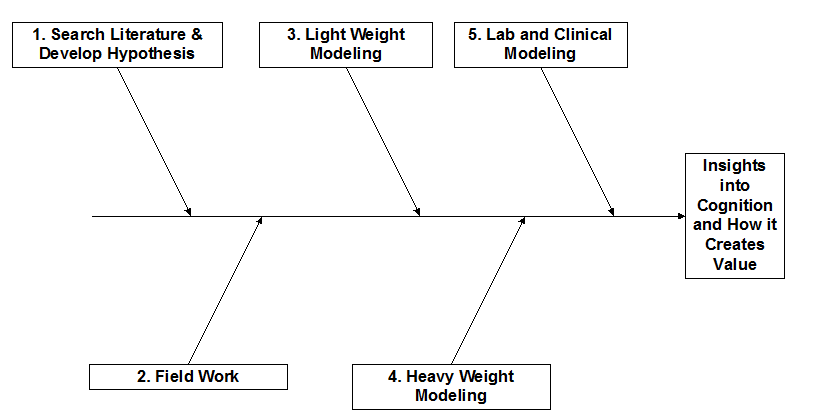
While many current innovation methods stress field work and rapid prototyping with users, it is often necessary to use light-and-heavy weight modeling methods to generate real insights into how to move hearts and minds.

Posted in Psychographics, Technique | 1 Comment »
August 19th, 2012
 Yes, claim the authors of God is Like a Drug: Explaining Interaction Ritual Chains in American Megachurches, a paper being presented today at an American Sociological Association Meeting. According to the authors churches with 2000+ members (a megachurch) create a powerful emotional experience using charismatic leaders, stagecraft, small group dynamics, sensory rich pageantry and environments and deeply positive and consistent messaging. All key elements of cognitive and experience design. To quote:
Yes, claim the authors of God is Like a Drug: Explaining Interaction Ritual Chains in American Megachurches, a paper being presented today at an American Sociological Association Meeting. According to the authors churches with 2000+ members (a megachurch) create a powerful emotional experience using charismatic leaders, stagecraft, small group dynamics, sensory rich pageantry and environments and deeply positive and consistent messaging. All key elements of cognitive and experience design. To quote:
Many participants used the word “contagious” to describe the feeling of a megachurch service where members arrive hungry for emotional experiences and leave energized. One church member said, “(T)he Holy Spirit goes through the crowd like a football team doing the wave. …Never seen it in any other church.”
I am interested to hear from readers that attend megachurches. What can they teach us about cognitive design?

Posted in Service Innovation | 1 Comment »
 Likeable people have more influence and get more offers. Likeable employees sell more products and delivery more satisfying customer service. Likeable leaders and managers are far more effective. It is little wonder that becoming more likeable and creating lovable products and services is big business for designers.
Likeable people have more influence and get more offers. Likeable employees sell more products and delivery more satisfying customer service. Likeable leaders and managers are far more effective. It is little wonder that becoming more likeable and creating lovable products and services is big business for designers.









